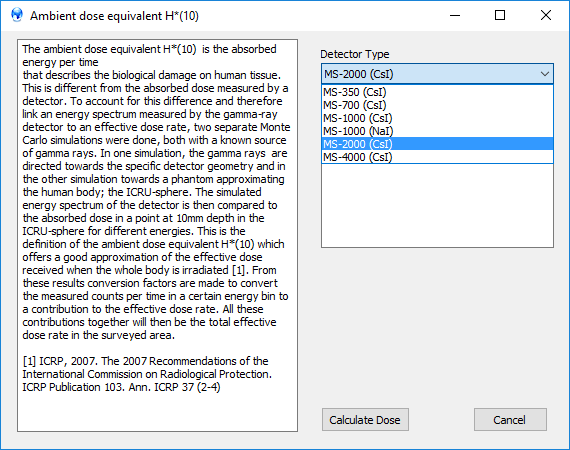15. Determining dose rate
Gamman offers a feature that calculates the dose rate from collected gamma-ray data. It is taken from the full measured spectrum and represents the dose per second that the full body of an average person would receive if they were located at the spot where the detector collected the spectrum. So, for example, if a spectrum was measured at 5 meters above the ground, the dose rate is calculated for that height and not as if someone was standing on the ground. Gamman does not offer the possibility for height correction of the dose rate.
The dose rate for the average human body, known as the ambient dose equivalent H*(10), is calculated through the total counts of the measured spectrum per energy bin and a detector specific factor. This factor is constructed from two types of Monte Carlo simulations. One of them contains a sphere that is representing the human body (the ICRU sphere.) A point at 10 mm depth in this sphere is absorbing gamma-rays of certain energies. In the other simulation, those same gamma-rays are directed to and absorbed by a specific type of detector. In this way, the response of the detector can be linked to the dose received by the human body.
The contribution to the dose rate of the counts in all the energy bins for a data point are added by Gamman and this represents the dose rate for the specific data point.
The dose rate option can be accessed under the tab Tools|Ambient dose equivalent. The screen shown in the figure below will appear.

Here, the type of detector can be chosen, which holds the detector specific factor. After pressing “Calculate Dose”, the dose rate for every datapoint will be calculated and this will be added to the data as a separate column as “H*(10) in pSv/s.

A separate H*(10) column is added to the data
Note: a detector does measure dose rate directly, as can be seen in the mDOS interface, but this is not equivalent to the H*(10). It is just the number of counts of an energy bin multiplied by the energy of that bin summed. This calculation does not take the conversion from detector to human tissue into account.
Units - Grays and Sieverts
To report dose rates, often 2 units are used and sometimes even mixed: Grays and Sieverts. The Sievert (Sv) and the Gray (Gy) both have the same SI definition (J/kg), but they measure different aspects of of the effects radiation:
Gray (Gy):
The Gray is a unit of absorbed radiation dose. It measures the amount of energy that ionizing radiation deposits in a mass of tissue and is defined as one joule of radiation energy absorbed per kilogram of matter.
The Gray is used to quantify the amount of radiation received by an object or a person, regardless of the biological effects of that radiation.
Sievert (Sv):
The Sievert, on the other hand, is a unit that measures the biological effect of ionizing radiation. It takes into account the type of radiation and its impact on living tissue.
The Sievert is used in radiation protection to quantify the risk of radiation exposure to human health. It is a measure of the effective dose of radiation, considering the type of radiation and the sensitivity of various tissues and organs.
The Sievert allows for a more comprehensive assessment of potential harm from radiation, making it especially relevant for setting occupational exposure limits, medical diagnosis, and treatment planning.
In summary, the Gray measures the physical amount of radiation absorbed, while the Sievert measures the biological impact of that radiation on human health.
Conversion
To convert a radiation dose from Grays (Gy) to Sieverts (Sv), you need to take into account the radiation weighting factor, also known as the quality factor. This factor varies depending on the type of radiation (e.g., alpha particles, beta particles, gamma rays, neutrons) because different types of radiation have different biological effects for the same amount of absorbed dose.
The basic formula for the conversion is: Dose (Sv) = Dose (Gy) * Weighting factor
Here's how you would use this formula:
Determine the Type of Radiation: Identify the type of ionizing radiation involved (alpha, beta, gamma, neutrons, etc.).
Find the Radiation Weighting Factor: Look up the radiation weighting factor for that type of radiation. Here are some common factors:
Gamma rays, X-rays, beta particles: 1
Thermal neutrons: around 2.5 (but can be as high as 20 for higher energy neutrons)
Fast neutrons: 20
Alpha particles: 20
Calculate the Dose in Sieverts: Multiply the absorbed dose in Grays by the appropriate radiation weighting factor to get the dose in Sieverts.
For example, if a person receives an absorbed dose of 0.5 Gy from gamma rays, the equivalent dose in Sieverts would also be 0.5 Sv, because the radiation weighting factor for gamma rays is 1.
